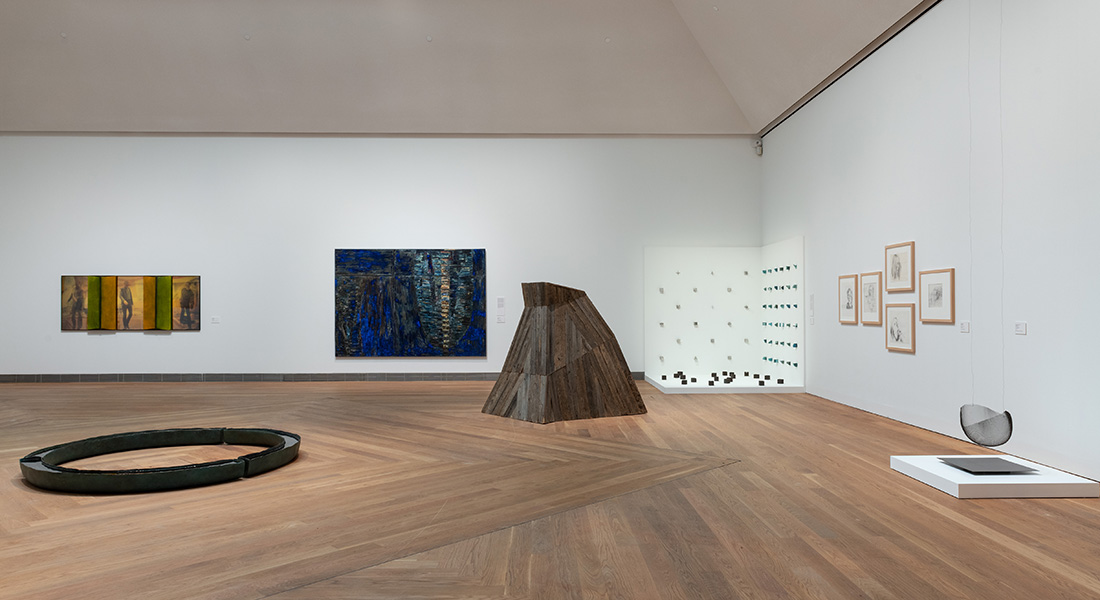
Stig Sjölund, Untitled, 1988. Babro Bäckström, Cirkus JRR, 1988, Sculpture No. II/Bearing–Borne (Memory), 1884. Marika Mäkelä, Soon the Wind Died Down. Stina Ekman, The Groke, Gitter, 2023. Photo: Åsa Lundén/Moderna Museet Bildupphovsrätt 2023
Room 3
Stina Ekman, Barbro Bäckström, Eva Löfdahl, Max Book, Stig Sjölund, Marika Mäkelä and others
Runtime: 04:03
Narrator: I mentioned earlier that this exhibition highlights a number of seminal women artists who represent an explorative approach to art and life. They had a feminist agenda, and their practices explore different positions: the position of the artist, the female artist, and also body positions, how they are placed in the room, how the works are positioned and placed in the room. Several of these artists taught at art colleges in Sweden. This means that they have influenced younger generations of artists.
Prominent sculptors included Stina Ekman, who creates works using a variety of materials, challenging our eyes, our experiences and our perception of form. “Lattice” was Stina Ekman’s major breakthrough. It was first shown at Moderna Museet in 1985. The work originally consisted of hundreds of cubic mini sculptures that filled the walls and floor of an entire room. A small number of these were acquired for the collection and are presented here. Every part has the same dimensions, based on a six-centimetre cube, but they are made of different materials of varying weight and texture. The Swedish title, “Gitter”, can mean grate or grid as a noun, and the verb ‘gitta’ means to ‘feel inclined’. The exhibition also features her sculpture“The Groke”, which resembles a character from Tove Jansson’s books about the Moomins.
Barbro Bäckström belongs to a slightly earlier generation. She is known mainly for her wire mesh sculptures of softly-moulded bodies, which she suspended in the middle of the space to allow the light to play with them. Her works grew increasingly abstract in the late 1970s. The characteristic bodies then gave way to objects in between abstraction, nature and metaphor. The hanging sculpture “Carry-Carried” is an example of this. “Circus” in the middle of the room is a circular bronze vessel filled with water. Also presented here is her expressive print of a reclining goddess of liberty.
Eva Löfdahl has been one of Sweden’s most innovative artists since her debut in the early 1980s. She has tried out many different techniques and formats over the years. Most of her works seem simple and serene. But under the surface, there is a strong tension. She explores language, order, systems and hierarchies, often borrowing methods and approaches from the natural sciences. In the early 1980s, she belonged to the artist group Wallda. They shared a studio in Årsta in southern Stockholm, where they worked and exhibited together. The group also included Max Book and Stig Sjölund, who are also represented in this room.
Some of Moderna Museet’s most iconic works from this period were acquired in 1994 from the Rooseum Foundation. In a few intense years leading up to his AIDS-related death in 1991, the investment banker Fredrik Roos built a fine collection of contemporary art. The large painting by the Finnish artist Marika Mäkelä is from his collection. Fredrik Roos also supported the members of Wallda from the start.